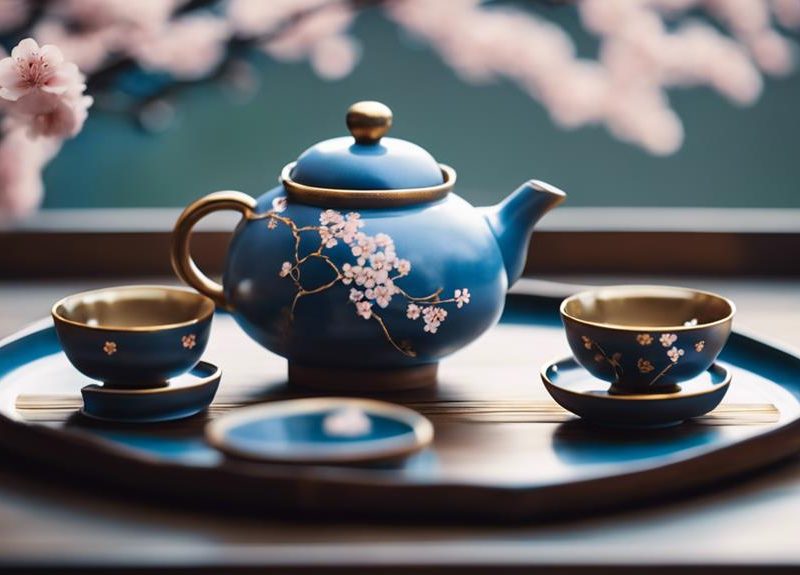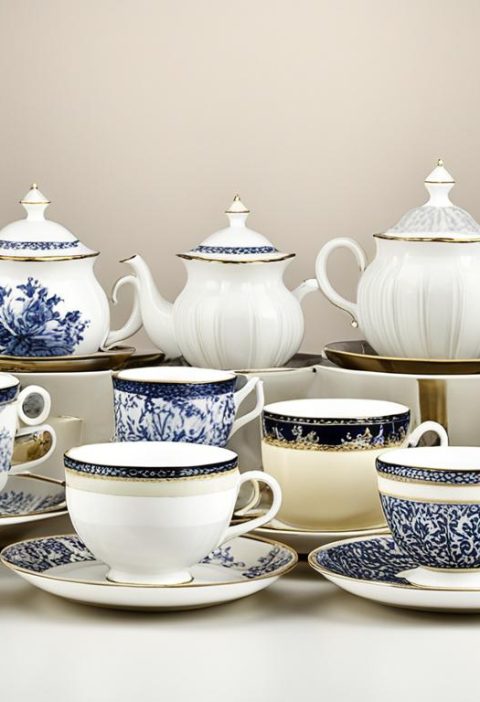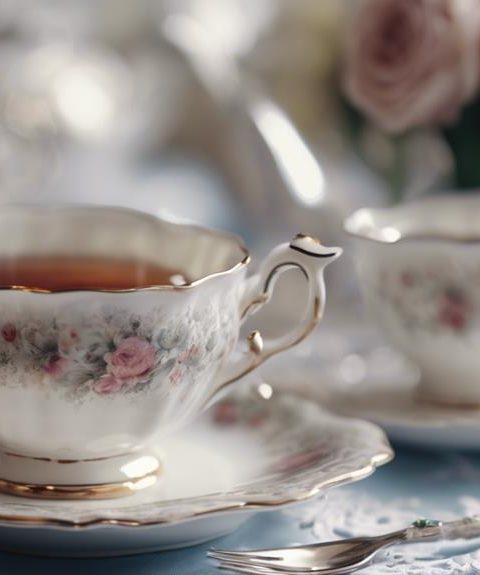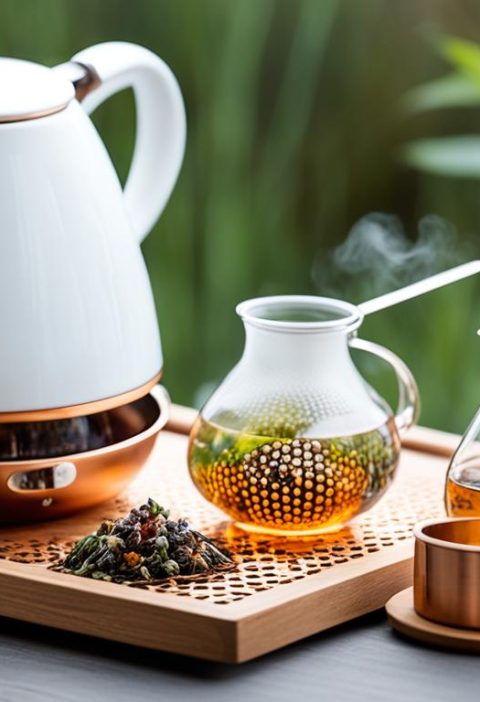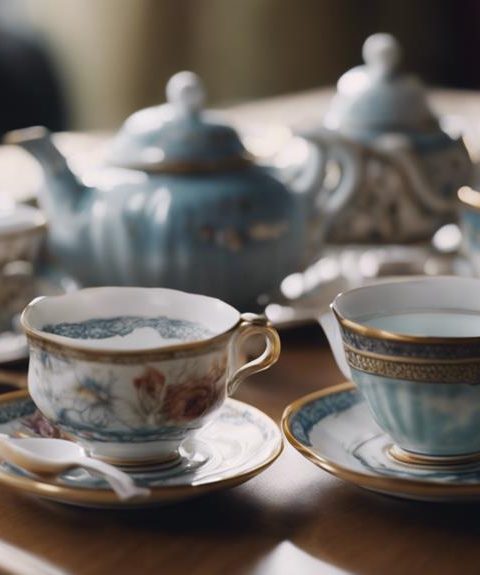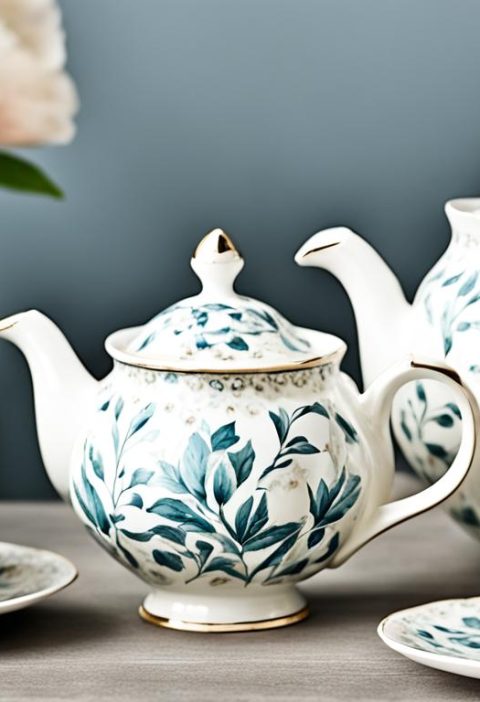Exploring the intricate world of tea set design unveils a rich tapestry of cultural symbolism spanning ancient dynasties like the Tang dynasty in China. In these tea sets, colors and patterns hold profound meanings; for example, the color red symbolizes joy. Animal motifs such as tigers and mythical symbols like dragons are woven into the designs, adding layers of significance.
These tea sets, integral to rituals and ceremonies, embody values of respect and unity. Over time, regional variations have emerged, each reflecting a unique cultural essence. From minimalist to sustainable interpretations, contemporary designs showcase a spectrum of creativity and innovation.
Delving into the realm of tea set design reveals a fascinating exploration of symbols and cultural heritage, inviting further discovery and appreciation.
Key Takeaways
Tea sets feature intricate designs that draw upon cultural symbols, such as dragons representing power and lotus flowers symbolizing purity. The choice of colors in tea sets, like the use of red to signify joy, adds layers of meaning to the experience. Animal motifs, such as tigers denoting courage and cranes symbolizing happiness, are common elements in tea set decoration. Geometric shapes are incorporated into tea set designs to enhance balance and highlight the craftsmanship involved in their creation. These tea sets play a significant role in various rituals, where they serve as symbols of hospitality, respect, and unity among participants.
Origins of Tea Set Symbolism
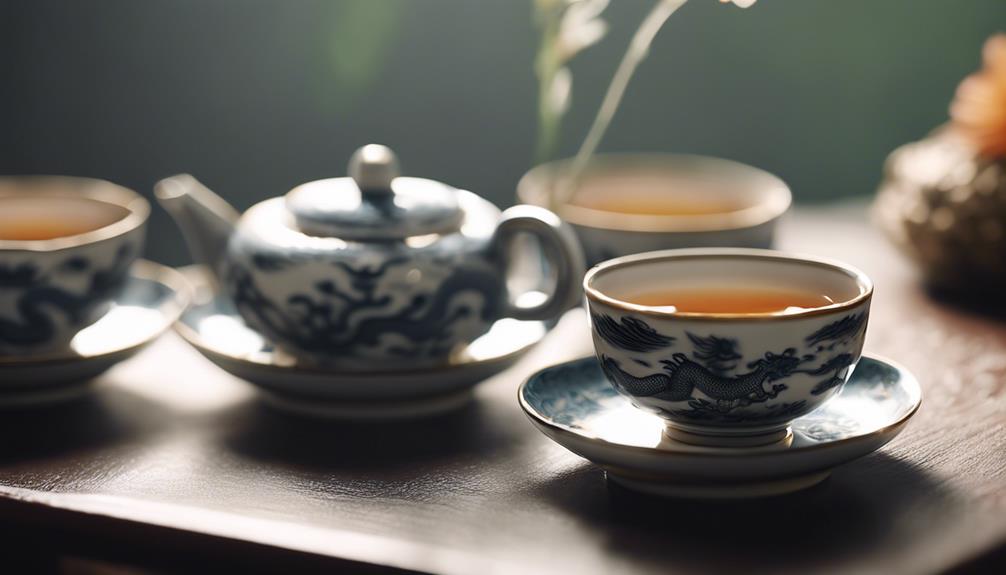
Tea set symbolism has a rich history originating from ancient Chinese dynasties, where intricate designs carried profound cultural meanings. These tea sets weren't merely functional vessels for serving tea but also held symbolic significance embedded in tradition and symbolism. The Tang dynasty, flourishing around the 8th century, witnessed the popularization of tea drinking, leading to the emergence of specialized tea wares adorned with symbols representing harmony, respect, and tranquility.
The patterns and motifs adorning tea sets often drew inspiration from nature, incorporating elements like flowers, birds, and landscapes to symbolize beauty, renewal, and balance. The shapes of the tea set components played a crucial role in conveying symbolism, with round shapes symbolizing unity and eternity, while square shapes represented stability and honesty.
Additionally, the choice of colors in tea set designs was meticulously made to convey specific meanings; for example, red symbolized joy and good fortune, while blue represented peace and serenity. Through these intricate design elements, tea sets transcended their utilitarian function, becoming vessels of cultural expression and tradition.
Cultural Influences on Tea Set Design
Tea set designs showcase a rich tapestry of cultural influences, blending traditions and artistic expressions from around the world. Each culture imbues its tea sets with a unique aesthetic, creating a diverse array of styles and motifs.
Chinese tea sets often feature intricate patterns and traditional symbols such as dragons and phoenixes, symbolizing power and harmony. In contrast, Japanese tea sets are renowned for their minimalist Zen-inspired designs, focusing on simplicity and tranquility. Indian tea sets dazzle with vibrant colors and elaborate patterns inspired by traditional textiles and jewelry.
Tea sets from the Middle East exhibit geometric patterns and arabesques, reflecting a heritage rich in craftsmanship and design. African tea sets incorporate earthy tones and tribal motifs, celebrating the continent's diverse cultural heritage.
The global landscape of tea set design is a fusion of cultural nuances, offering a glimpse into the artistic diversity and creativity of different societies.
Significance of Colors in Tea Sets
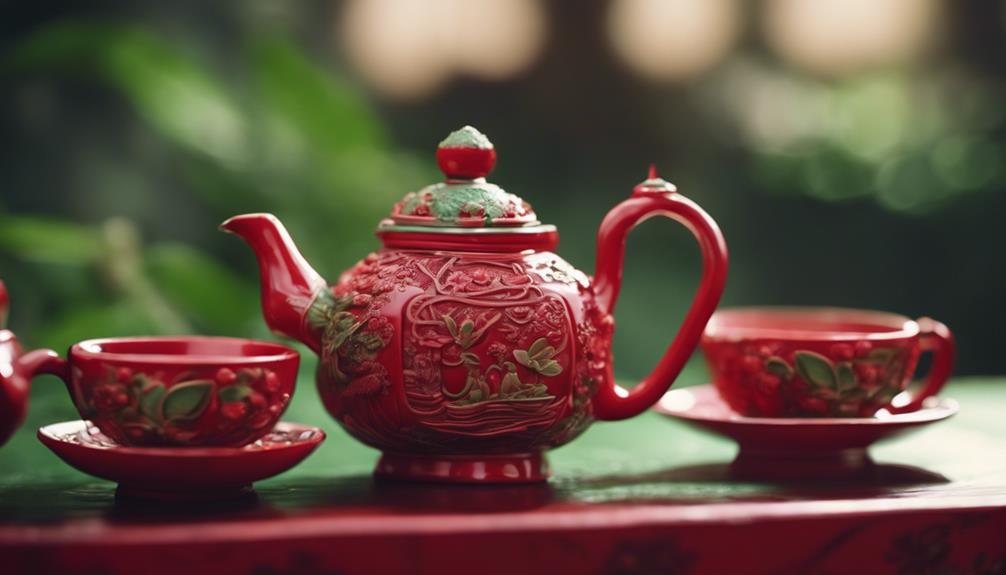
Colors in tea sets carry rich symbolic meanings across various cultures, shedding light on cultural preferences and aesthetic sensibilities. In Chinese culture, the color red signifies joy and prosperity, often chosen for tea sets used in festive occasions. Conversely, the combination of blue and white in Japanese tea sets symbolizes purity and grace.
In the Western context, gold and silver hues are linked to opulence and refinement, commonly seen in formal tea sets. Pastel shades like pink and lavender are favored in tea sets designed for afternoon tea, creating an atmosphere of calm and serenity.
The selection of colors in tea sets can also reveal personal inclinations and set the mood for the tea-drinking experience. Whether vibrant and striking or subtle and soothing, the colors of a tea set play a significant role in shaping the ambiance of a tea gathering.
Symbolism of Floral Patterns
Decorating tea sets with intricate floral patterns not only enhances their aesthetic appeal but also adds layers of symbolism and elegance to the design. The choice of floral motifs can convey various meanings, with different flowers symbolizing different virtues or emotions. For instance, roses often symbolize love and passion, while lilies represent purity and renewal. Incorporating these floral patterns into a tea set design not only beautifies it but also imbues it with deeper significance.
Floral patterns on tea sets can evoke a sense of nature and tranquility, creating a calming ambiance during tea ceremonies. The delicate beauty of flowers captured in these designs elevates the tea-drinking experience, making it more than just a simple beverage break. Moreover, the selection of specific flowers can reflect cultural influences or personal preferences, adding a unique touch to the symbolism of the tea set. Next time you admire a tea set adorned with floral patterns, take a moment to appreciate the hidden meanings and artistry behind each petal and leaf.
Geometric Shapes in Tea Set Design
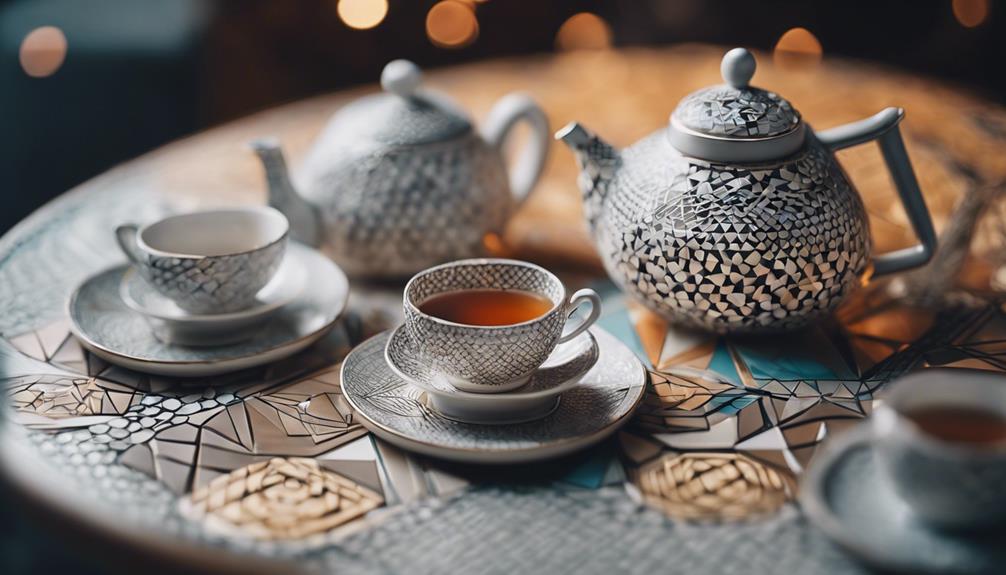
Geometric shapes infuse a contemporary and structured essence into the design of tea sets, blending modernity with traditional aesthetics. The incorporation of geometric patterns in tea sets can represent concepts of balance, harmony, and precision, offering a unique visual appeal.
Let's explore the impact of geometric shapes on tea set design through various perspectives:
- Symmetry: Geometric shapes accentuate symmetry, fostering a sense of balance and order in the overall design.
- Repetition: The recurring geometric patterns create a sense of rhythm and continuity, elevating the visual allure of the tea set.
- Contrast: Introducing a mix of different geometric shapes adds contrast, enhancing the dynamic and visually captivating nature of the design.
- Precision: Geometric shapes demand meticulous attention to detail, showcasing the craftsmanship and expertise involved in crafting the tea set.
- Modernization: By incorporating geometric elements, traditional tea sets receive a contemporary makeover, appealing to modern sensibilities while upholding cultural traditions.
Animal Motifs and Their Meanings
Exploring the symbolism of tigers, the significance of cranes, and the meaning behind fish in tea set designs reveals deep cultural meanings embedded in these animal motifs. These elements play a crucial role in shaping the symbolic language of tea sets, shedding light on the intricate cultural tapestry they represent.
Tigers, revered for their strength and power, symbolize courage, protection, and energy in tea set designs. They embody authority and resilience, adding a sense of majesty and fearlessness to the overall symbolism of the tea set.
Cranes, known for their grace and longevity, hold a special significance in tea set motifs. Representing happiness, good fortune, and peace, cranes symbolize harmony and balance. Their presence in tea set designs conveys wishes for a peaceful and prosperous life.
Fish, a symbol of abundance, wealth, and prosperity in many cultures, carry a similar significance in tea set designs. Depicted swimming gracefully in the intricate patterns, fish symbolize good luck, success, and surplus. They embody the hopes for a bountiful and flourishing future.
Symbolism of Tigers
Tigers in tea set design embody a rich symbolism, reflecting attributes such as strength, power, and protection. The inclusion of tigers in tea sets conveys a multitude of meanings:
- Courage: Tigers are revered for their boldness and dauntless nature.
- Leadership: They epitomize authority and command admiration.
- Independence: Tigers, as solitary beings, symbolize self-reliance.
- Vitality: Their boundless energy and dynamism signify vitality and fervor.
- Guardianship: Tigers are viewed as guardians, shielding against harm and negativity.
Integrating these symbolic representations not only enhances the visual allure of the tea set but also infuses it with profound significance, enriching the tea-drinking ritual.
Significance of Cranes
Cranes, with their graceful flight and symbolic significance, bring elements of elegance, longevity, and good fortune to tea sets. In the realm of tea set design, cranes embody more than just visual appeal. These majestic birds, known for their loyalty and honor, are believed to usher in joy and prosperity.
By adorning tea sets with images of cranes, artisans seek to create a serene and harmonious atmosphere for tea enthusiasts. The intricate portrayal of cranes on teapots and cups captures their essence of grace and poise, adding a touch of beauty to the tea-drinking experience.
Through the presence of cranes on tea sets, a sense of tranquility and positive energy is infused into the ritual, enhancing the overall enjoyment of sipping tea.
Meaning Behind Fish
Fish motifs in tea set designs symbolize abundance, prosperity, and harmony, conveying deeper meanings beyond their visual appeal. The incorporation of fish symbols into tea sets infuses a sense of auspiciousness and positive energy into the tea-drinking experience. Some key symbolisms associated with fish motifs include:
- Abundance: Fish symbolize plentiful resources and wealth.
- Harmony: The graceful movement of fish in water signifies balance and tranquility.
- Fertility: Fish are often associated with fertility and the continuity of life.
- Transformation: Their adaptability to different environments represents flexibility and transformation.
- Success: In Chinese culture, fish are linked to success and progress.
Mythological Symbols in Tea Sets
Tea sets are enriched with ancient mythological symbols that hold profound cultural significance and historical narratives. These symbols embody the beliefs, stories, and values cherished by diverse cultures over time. Delve into the symbolism present in tea sets with the following mythological entities:
- Dragon: Symbolizing power, strength, and good luck, the dragon is a revered figure in many Eastern cultures.
- Phoenix: Representing themes of rebirth, immortality, and transformation, the phoenix is a prevalent symbol associated with renewal.
- Lotus Flower: Known for its purity, enlightenment, and divine beauty, the lotus flower thrives in muddy waters, symbolizing resilience and grace.
These mythological symbols infuse the act of tea-drinking with layers of meaning, connecting individuals to ancient narratives and cultural beliefs.
Tea Sets in Rituals and Ceremonies
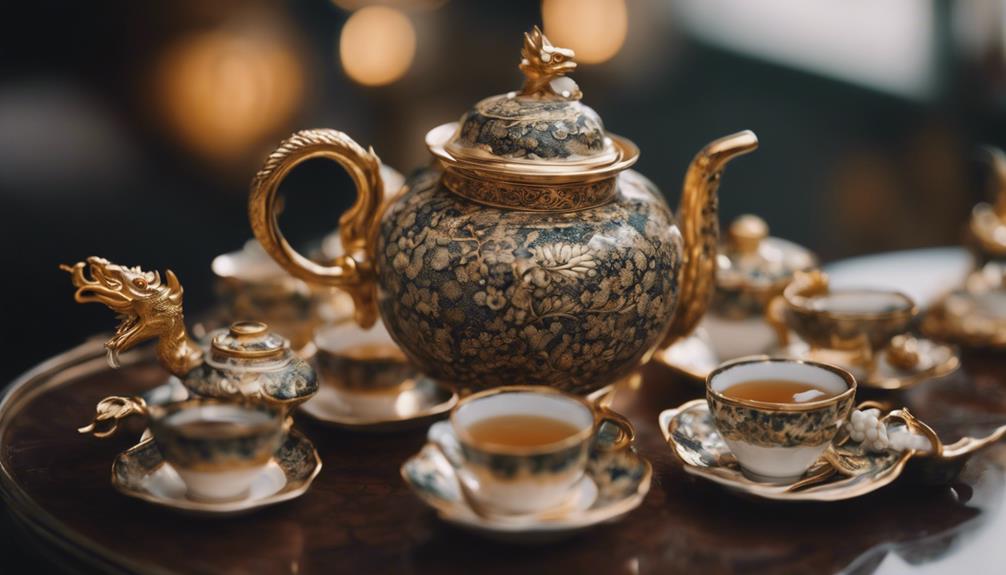
Tea sets hold significant roles in a variety of rituals and ceremonies, enriching the atmosphere and importance of these cultural practices. They serve as symbols infused with meanings that enhance the experience for participants. Here are some ways in which tea sets are integrated into rituals and ceremonies:
- Symbol of Hospitality: Tea sets symbolize hospitality and respect when offering tea to guests, a gesture deeply rooted in many cultures.
- Connection with Nature: Some tea sets are meticulously crafted to mirror elements of nature, fostering a profound connection with the environment during tea rituals.
- Ceremonial Purification: In certain rituals, tea from these sets is utilized for ceremonial purification and cleansing rituals, symbolizing renewal and spiritual cleansing.
- Preservation of Cultural Heritage: Tea sets often embody a community's cultural heritage and traditions, representing a legacy passed down through generations.
- Facilitator of Social Bonds: Sharing tea from elegantly designed tea sets cultivates social bonding and strengthens relationships among participants, creating a sense of unity and camaraderie.
These diverse roles of tea sets in rituals and ceremonies highlight their versatility and significance beyond their utilitarian function, making them integral elements in cultural practices worldwide.
Evolution of Tea Set Symbolism
Delve into the captivating evolution of tea set symbolism throughout history, where cultural influences have shaped the intricate designs, reflecting a tapestry of traditions and beliefs. Explore how diverse cultural backgrounds have influenced the symbolism embedded in tea sets, showcasing a blend of past and present interpretations.
Tea sets, as cultural artifacts, encapsulate a rich tapestry of meanings that have evolved over time. The designs of these sets are a reflection of the cultural beliefs and traditions of the societies that created them. By examining the symbolism embedded in tea sets, one can gain a deeper understanding of the cultural contexts in which they were produced.
From traditional motifs to contemporary interpretations, the symbolism of tea sets continues to evolve, showcasing a dynamic interplay between heritage and innovation. By exploring the intricate details of tea sets, one can uncover layers of meaning that speak to the complexities of cultural identity and expression.
Whether through ancient symbols or modern reinventions, tea sets offer a window into the diverse narratives that have shaped their symbolism. By tracing the journey of tea set symbolism, one can appreciate the enduring significance of these objects in celebrating cultural heritage and artistic expression.
Historical Tea Set Meanings
The evolution of tea set design and symbolism is a complex tapestry woven with diverse cultural influences and societal values. From ancient traditions to modern personalization, tea sets have reflected a myriad of meanings and purposes throughout history:
- Influences from China: Early tea sets drew inspiration from Chinese culture, incorporating motifs that carried deep symbolic significance.
- Victorian Era Symbolism: In the Victorian era, tea sets were adorned with intricate floral designs symbolizing notions of purity and femininity, reflecting the societal values of the time.
- Art Deco Movement Influence: During the Art Deco period, tea sets embraced bold geometric shapes and vibrant colors, symbolizing a shift towards modernity and progress in design aesthetics.
- Japanese Aesthetics: Japanese tea sets are characterized by minimalist and Zen-inspired designs, embodying principles of simplicity, tranquility, and harmony.
- Modern Personalization Trends: Today, tea sets offer a canvas for personal expression and customization, allowing individuals to imbue their sets with unique symbolism that resonates with their personal preferences and styles.
Tea sets have thus evolved over time to serve not only functional purposes but also as carriers of cultural heritage, artistic expression, and personal symbolism, reflecting the diverse and ever-changing meanings attributed to this beloved beverage tradition.
Cultural Influences on Design
The evolution of tea set symbolism in design has been a rich and dynamic journey through history, drawing deeply from diverse cultural influences. Chinese porcelain showcases intricate patterns, Japanese tea sets embody elegant simplicity, and Indian tea sets feature ornate detailing reflecting a rich tapestry of traditions.
Moroccan tea sets display vibrant colors and geometric patterns inspired by Islamic art, while European tea sets often highlight delicate floral motifs influenced by Rococo and Art Nouveau movements. These cultural elements intertwine to create a tapestry of symbolism that continues to captivate and inspire tea set enthusiasts worldwide.
Modern Tea Set Symbolism
The evolution of tea set symbolism in design has embraced modern influences, ushering in a new era where traditional motifs intertwine with contemporary aesthetics to redefine the essence of tea set symbolism. Modern tea set designs now reflect a fusion of past and present, encapsulating deeper meanings within their forms. The symbolism behind these modern tea sets is intricate, serving as a blend of cultural heritage and innovation.
As you explore modern tea set designs, consider the following aspects:
- The inclusion of minimalist shapes symbolizes simplicity and harmony, reflecting a Zen-like approach to design.
- Geometric patterns are used to represent balance and order, adding a touch of modern sophistication to the tea set.
- Sustainable materials like bamboo and recycled glass signify environmental consciousness, promoting eco-friendly practices in design.
- Bold colors are incorporated to evoke energy and vitality, infusing a sense of vibrancy into the tea set aesthetic.
- Innovative functions cater to adaptability in modern lifestyles, offering practical solutions for contemporary tea rituals.
In essence, modern tea sets blend traditional symbolism with contemporary design elements to create a harmonious balance between heritage and innovation, appealing to a wide range of tea enthusiasts seeking both cultural depth and modern flair in their tea experiences.
Regional Variations in Tea Set Design
Tea sets across various regions showcase a rich tapestry of cultural influences in their design. Chinese tea sets, known for their delicate porcelain and intricate hand-painted designs, symbolize values like harmony and prosperity. Japanese tea sets, on the other hand, embody simplicity and elegance with minimalist designs reflecting Zen philosophies.
British tea sets, crafted from fine bone china, display floral patterns and gold accents, exuding sophistication. Russian tea sets, inspired by the country's history and folklore, feature vibrant colors and ornate patterns.
Whether you appreciate the ornate beauty of Chinese tea sets, the serene simplicity of Japanese designs, or the luxurious elegance of British tea sets, each region's cultural essence shines through in the intricate details of their tea set designs.
Gender and Tea Set Symbolism
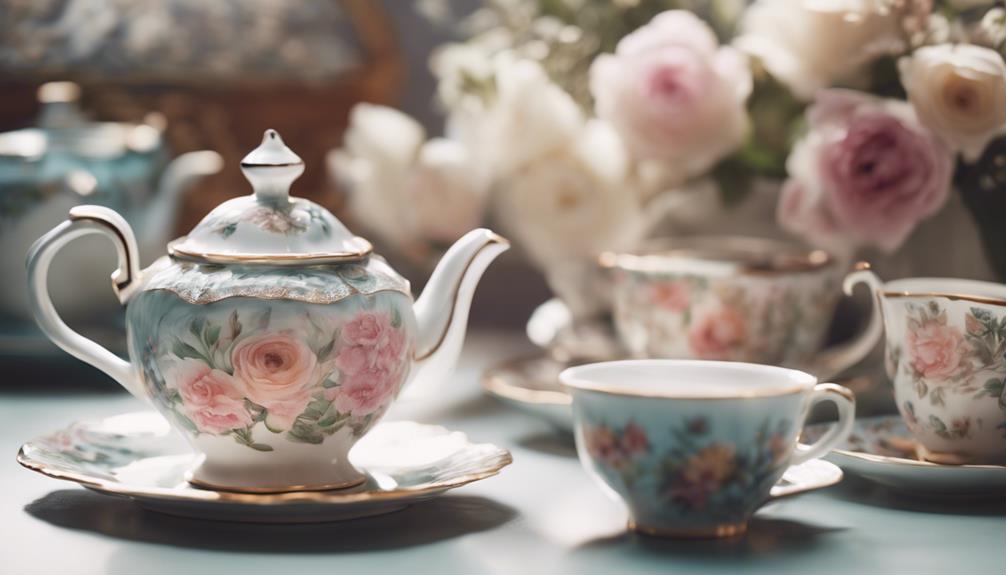
When exploring the symbolism of tea sets, it's essential to consider the colors, shapes, and patterns incorporated. These design elements may reflect traditional notions of femininity or masculinity, shaping the perception and utilization of tea sets.
Understanding these associations offers valuable insights into the cultural significance of tea sets across various contexts.
Tea Set Colors
Colors in tea set design carry rich symbolism, reflecting diverse perspectives on gender norms and societal constructs. Here are some interpretations of tea set colors in terms of gender symbolism:
- Pink: Often associated with notions of femininity, grace, and sensitivity.
- Blue: Traditionally linked to masculinity, strength, and stability.
- Yellow: Symbolizing warmth, joy, and inclusivity, often perceived as gender-neutral.
- Green: Represents growth, renewal, and balance, sometimes aligned with feminine attributes.
- Gold: Signifying opulence, sophistication, and allure, appealing universally across genders.
These color associations in tea sets showcase how gender symbolism can be expressed through nuanced design choices, integrating varied approaches and perspectives.
Shapes and Patterns
Tea set design incorporates a variety of shapes and patterns that convey subtle messages related to gender symbolism, adding depth to the overall aesthetic appeal. Delicate floral patterns and curvy, rounded shapes are often associated with femininity, suggesting elegance and grace.
In contrast, angular shapes and bold geometric patterns are typically linked with masculinity, implying strength and structure. These gendered symbols in tea set design reflect societal norms and expectations concerning gender roles.
Historical Gender Associations
Gender symbolism in tea set design reflects traditional perceptions of masculinity and femininity through various elements:
- Color: Pink and floral designs are often associated with femininity, while darker and earthy tones may be linked to masculinity.
- Shape: Curved and delicate forms can symbolize femininity, whereas angular and robust shapes may signify masculinity.
- Decorative Elements: Images of flowers, birds, or delicate patterns are commonly used to represent femininity, while bold geometric patterns or symbols may convey masculinity.
- Size: Smaller, intricate tea sets have historically been associated with femininity, whereas larger, more substantial sets may be connected to masculinity.
- Materials: Fine china and porcelain are typically linked to femininity, while metals like silver or pewter are often associated with masculinity.
These design choices in tea sets have been influenced by societal norms and historical contexts, shaping how gender roles are perceived and reinforced through material culture.
Tea Sets as Status Symbols
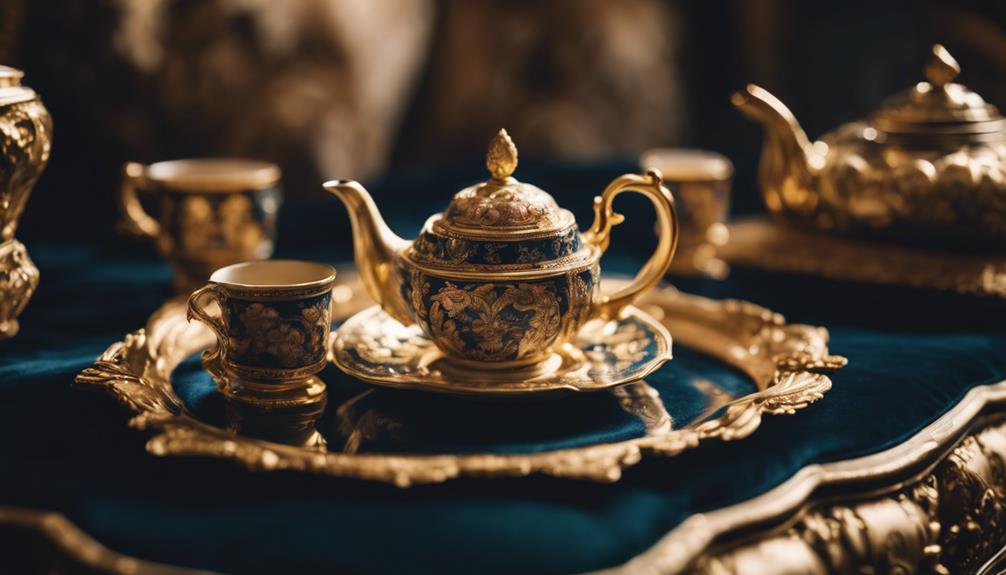
Owning a tea set can symbolize status and refinement in many cultures, showcasing the owner's social standing and taste. The design intricacy, choice of materials, and skilled craftsmanship all contribute to the perceived value of a tea set.
In various societies, possessing a beautiful tea set signifies wealth and elegance. Displaying a luxurious tea set during social gatherings or formal occasions can communicate authority and prestige. Throughout history, tea sets have been utilized by the elite to demonstrate their elevated position in society.
Some cultures incorporate specific symbols or motifs into tea set designs to indicate the owner's lineage or group affiliation. Serving tea in an ornate set can subtly communicate one's status and importance to others. Even in modern times, having a high-quality tea set remains a sophisticated way to exhibit social standing and appreciation for fine artistry.
Contemporary Interpretations of Tea Set Symbolism
In the realm of contemporary design, tea sets have transcended their traditional role to become symbols of artistry and practicality. These modern interpretations of tea set design showcase a fusion of creativity and functionality, reflecting the evolving tastes and preferences of today's society.
Here are five ways in which tea set symbolism has evolved in contemporary design:
- Sleek Minimalism: Tea sets characterized by clean lines and minimalist aesthetics embody a sense of simplicity and a touch of modernity.
- Cultural Synthesis: Designs that intertwine elements from diverse cultural traditions symbolize the interconnected nature of our global society.
- Emphasis on Sustainability: Tea sets crafted from eco-friendly materials and featuring reusable components serve as a testament to a dedication to environmental consciousness.
- Integration of Technology: Modern tea sets that seamlessly incorporate technological features, such as temperature control mechanisms, bridge the gap between tradition and innovation.
- Personalized Expression: Customizable tea sets empower individuals to showcase their unique style and preferences, infusing a personalized touch into the age-old ritual of tea drinking.
Frequently Asked Questions
Can the Shape of a Tea Set Affect the Taste of the Tea?
The shape of a tea set can significantly impact the taste of the tea you enjoy. This is because the design plays a crucial role in how the aroma and flavors of the tea are released and experienced. By selecting the right shape for your tea set, you can enhance your overall tea-drinking experience by maximizing the sensory elements involved.
Are There Any Superstitions Associated With Using Certain Tea Sets?
Using specific tea sets can be associated with superstitions that are believed to bring luck or ward off negative energy. It is important to be aware of the traditions and beliefs surrounding tea set usage to ensure a positive experience.
How Do Different Tea Sets Impact the Tea-Drinking Experience?
The design, material, and craftsmanship of tea sets significantly influence the tea-drinking experience. These aspects impact the mood, aesthetics, and overall sensory enjoyment of the tea session. Different tea sets, with their unique designs and materials, enhance the appreciation and pleasure derived from drinking tea.
Can the Material of a Tea Set Influence the Overall Symbolism?
The symbolism of a tea set can be greatly influenced by the material it is made of. For example, porcelain may evoke elegance and delicacy, while cast iron could symbolize strength and resilience. When choosing a tea set, consider the material that aligns with the symbolism you want to convey.
Are There Any Taboos Related to Gifting Tea Sets in Certain Cultures?
When gifting tea sets in certain cultures, it is important to be aware of potential taboos associated with this practice. Understanding the traditional beliefs and customs related to tea set gifting can help you navigate these taboos respectfully. It is crucial to consider the cultural significance behind the act of presenting tea sets as gifts to avoid any unintended offense or misunderstanding.
Conclusion
The intricate designs found on tea sets hold a wealth of cultural and symbolic meanings, reflecting a blend of influences from various regions and traditions. These designs, whether in the form of colors, patterns, or shapes, carry layers of significance that enrich the experience of tea drinking. When you raise a delicate tea cup to your lips, you aren't just savoring a beverage but also immersing yourself in a tapestry of symbols and cultural expressions woven into the very essence of the tea set.
By exploring the symbolism behind tea set designs, you can uncover a world of cultural nuances, regional customs, and historical legacies. Each element of the tea set, from the intricate motifs to the choice of materials, contributes to a narrative that transcends mere aesthetics. Whether you're admiring the delicate floral patterns of a Chinese tea set or the bold geometric designs of a Japanese tea set, each piece tells a story that invites you to delve deeper into its cultural significance.
So, the next time you engage with a tea set, take a moment to appreciate the intricate symbolism and cultural richness it embodies. In doing so, you not only enhance your tea drinking experience but also gain a deeper understanding of the diverse traditions and narratives that have shaped the art of tea consumption across the globe.
